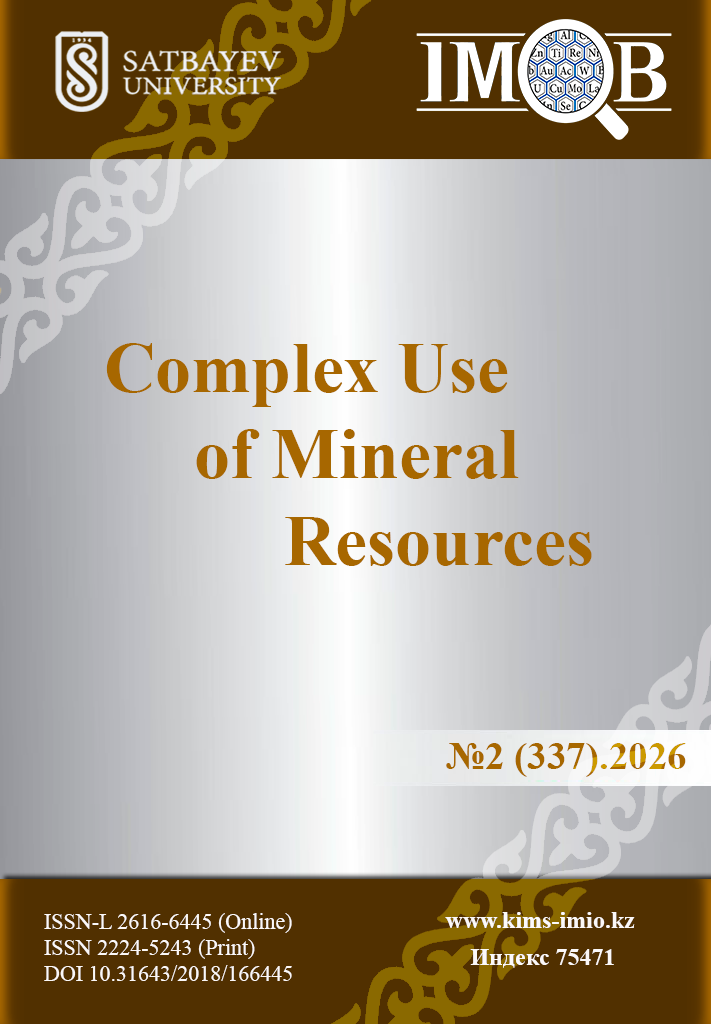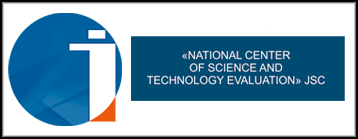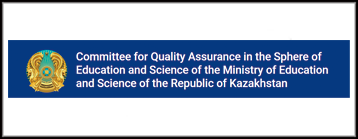Monitoring of the earth's surface and mining facilities by radar interferometry
DOI:
https://doi.org/10.31643/2026/6445.18Keywords:
radar interferometry, radar sensing of the Earth, synthesized aperture radar, interferometric processing methods, radar sensors, surface deformation, mining industry.Abstract
Safe and efficient development of mineral deposits by underground method, occurring at great depths, is complicated by the fact that with an increase in the depth of mining, the nature of the course of deformation processes in the rock mass and the degree of their impact on the environment change significantly. Studies of deformation processes, their control and forecast in many cases determine the efficiency and safety of the development of deposits of solid minerals. A practical forecast can be made as a result of continuous tracking in space and time of deformation processes. This article presents modern satellite radars and their main characteristics. The features of the radar interferometry method are described, and the advantages and disadvantages of various methods of interferometric processing of radar images are considered. The experience of using space radar for monitoring mineral deposits in the Republic of Kazakhstan is analyzed. The question was raised about the possibility of intensifying the use of radar interferometry in the mining industry. Regular field observations are provided throughout the mining site, including hard-to-reach and dangerous areas, regardless of weather conditions. It is confirmed that the use of the radar interferometry method determines the displacement of the earth's surface with high accuracy. When using this method, data is received and processed remotely and generally does not require presence on the site. In addition, this article provides examples of successful application of the radar interferometry method in foreign countries at mining and oil facilities. Also, the use of radar interferometry allows you to quickly determine the zones of possible deformations of the earth's surface and organize high-precision surveying and geodetic observations in these zones. In this article, radar interferometry has been used to monitor the surface movement of the Annensky field with high accuracy since 2016 using Sentinel radar images, and as a result, a displacement map of the earth's surface has been generated.
Downloads
References
Knospe S, et al. Die Anwendung der satellitengestützten Radarinterferometrie zur großräu-migen Erfassung von Höhenänderungen. Tagungsband GeoMonitoring, Clausthal-Zeller-feld. 2011; 3-4.
Ciampalini A, Solari L, Giannecchini R, Galanti Y, & Moretti S. Evaluation of subsidence induced by long-lasting buildings load using InSAR technique and geotechnical data. The case study of a Freight Terminal (Tuscany, Italy). International Journal of Applied Earth Observation and Geoinformation. 2019; 82:101925. https://doi.org/10.1016/j.jag.2019.101925
Crosetto M, Monserrat O, Cuevas-González M, Devanthéry N, & Crippa B. Persistent scatterer interferometry. A review. ISPRS Journal of Photogrammetry and Remote Sensing. 2016; 115:79-89. https://doi.org/10.1016/j.isprsjprs.2015.10.011
Du Z, Ge L, Li X, & Ng A H M. Subsidence monitoring over the Southern Coalfield, Australia using both L-Band and C-Band SAR time series analysis. 2016; 8(7):543. https://doi.org/10.3390/rs8070543
Ferretti A, Fumagalli A, Novali F, Prati C, Rocca F, & Rucci A. A new algorithm for processing interferometric data stacks: SqueeSAR. IEEE Transactions on Geoscience and Remote Sensing. 2011; 49(9):3460-3470. https://doi.org/10.1109/TGRS.2011.2124465
Kantemirov Yu I. Kratkiye teoreticheskiye osnovy radarnoy interferometrii i yeye mnogoprokhodnykh variatsiy Ps i SBas [Brief theoretical foundations of radar interferometry and its multi-pass variations Ps and SBas]. Geomatika [Geomatics]. 2012; 1:22-26.
Pimanov I Yu, Ponomarenko M R. Ispol'zovaniye geoinformatsionnykh tekhnologiy i dannykh radiolokatsionnoy s"yomki dlya monitoringa ob"yektov gornogo proizvodstva [Use of geoinformation technologies and radar survey data for monitoring mining facilities]. Materialy 9-y konferentsii «Informatsionnyye tekhnologii v upravlenii» (ITU-2016), Sankt-Peterburg: OAO Kontsern TSNII Elektropribor [Proceedings of the 9th conference Information Technologies in Management (ITU-2016), St. Petersburg: JSC Concern Central Research Institute Elektropribor]. 2016. 435-439.
Hu J, Li Z W, Ding X L, Zhu J J, Zhang L, & Sun Q. Resolving three-dimensional surface displacements from InSAR measurements. A review. Earth-Science Reviews. 2014; 133:1-17. https://doi.org/10.1016/j.earscirev.2014.02.005
Gousie MB, & Franklin WR. Augmenting grid-based contours to improve thin plate DEM generation. Photogrammetric Engineering & Remote Sensing. 2005; 71(1):69-79. https://doi.org/10.14358/PERS.71.1.69
Haghighi MH, & Motagh M. Large-Scale interferometry, atmospheric effects, and ground deformation mapping. ZfV-Zeitschrift für Geodäsie, Geoinformation und Landmanagement. 2017, 4.
Ge L, Chang HC, Rizos C. Mine Subsidence Monitoring Using Multi-source Satellite SAR Images. Photogrammetric Engineering & Remote Sensing. 2007; 73(3):259-266.
Chang HC, Ge L, Rizos C. The Change of Ground Surface in 24 Hours. IEEE International Geoscience and Remote Sensing Symposium, IGARSS '05, Seoul, Korea. 2005; 7:5265-5267.
Ferretti A, Prati C, & Rocca F. Nonlinear subsidence rate estimation using permanent scatterers in differential SAR interferometry]. IEEE Transactions on Geoscience and Remote Sensing. 2000; 38(5):2202-2212. https://doi.org/10.1109/36.868878
Dzhunisbekova VE, Kurmanov BK, Bibosynov AZ, Ivanchukova AV, Kirsanov AV. Monitoring smeshcheniy zemnoy poverkhnosti po dannym radiolokatsionnoy s"yemki [Monitoring of Earth Surface Displacements Based on Radar Survey Data]. Mezhdunarodnaya konferentsiya Reshetnevskiye chteniya [International Conference "Reshetnev Readings]. 2013, 247-249.
Zhantayev Zh Sh, Fremd A G, Ivanchukova A V. Tekhnologiya obrabotki radiolokatsionnykh dannykh dlya monitoringa deformatsiy zemnoy poverkhnosti na mestorozhdenii Tengiz [Radar data processing technology for monitoring earth surface deformations at the Tengiz field]. Astana. 2012, 313-315.
Baranov YuB, Kozhina LYu, Kiselevskaya KE. Opyt ispol'zovaniya kosmicheskikh radiolokatsionnykh s"yemok v gidrologicheskikh issledovaniyakh [Experience of using space radar surveys in hydrological research]. 2012; 4:76-81.
Zhou X, Chang N-B, Li S. Applications of SAR Interferometry in Earth and Environmental Science Research. 2009; 9(3):1876-1912. https://doi.org/10.3390/s90301876
Odabay-Fard VV, Butkevich GR. Problemy razrabotki obvodnennykh peschano-graviynykh mestorozhdeniy [Problems of development of watered sand and gravel deposits]. Gornaya promyshlennost' [Mining industry]. 2012; 4:112-113.
Kashnikov YuA, Musikhin VV, Lyskov IA. Opredeleniye osedaniy zemnoy poverkhnosti pri razrabotke mestorozhdeniy poleznykh iskopayemykh po dannym radarnoy interferometrii [Determination of subsidence of the earth's surface during the development of mineral deposits using radar interferometry data]. FTPRPI. 2012; 4:68-77.
Sadykov B B. Improving the risk management method in conditions of intensive deposit development based on the use of GIS technology: PhD dissertation: 6D071100. Almaty. 2022, 76.
Sadykov B, Altayeva A, & Stelling W. Monitoring of displacements and deformations of the earth’s surface at the Annensky field. Kompleksnoe Ispolzovanie Mineralnogo Syra = Complex Use of Mineral Resources. 2021; 322(3):43-50. https://doi.org/10.31643/2022/6445.27
Downloads
Published
How to Cite
Issue
Section
License
Copyright (c) 2025 A.A. Altayeva, B.B. Sadykov, A.B. Umirbayeva, A.B. Darkenbaeva, A. Dastan

This work is licensed under a Creative Commons Attribution 4.0 International License.


























